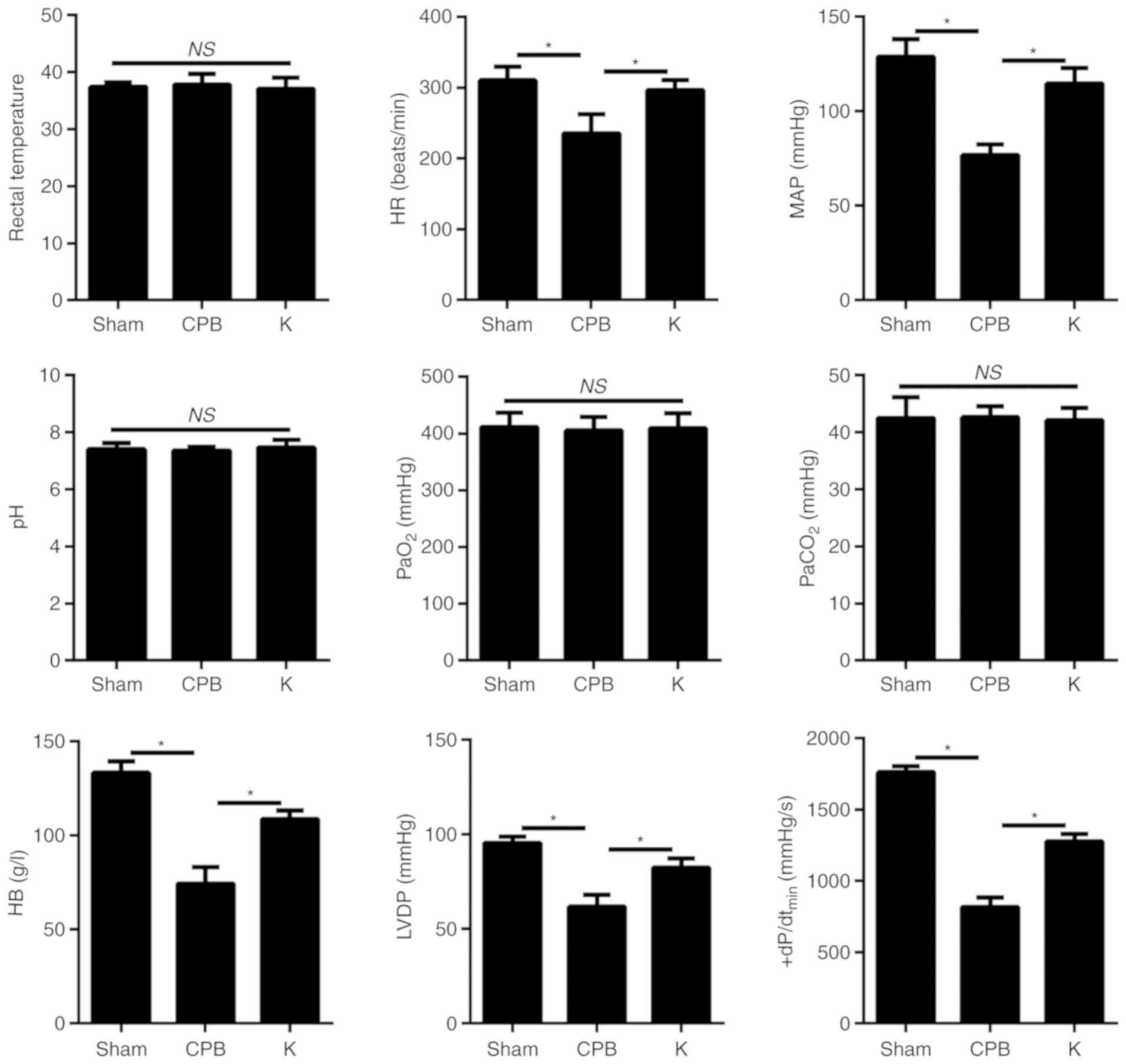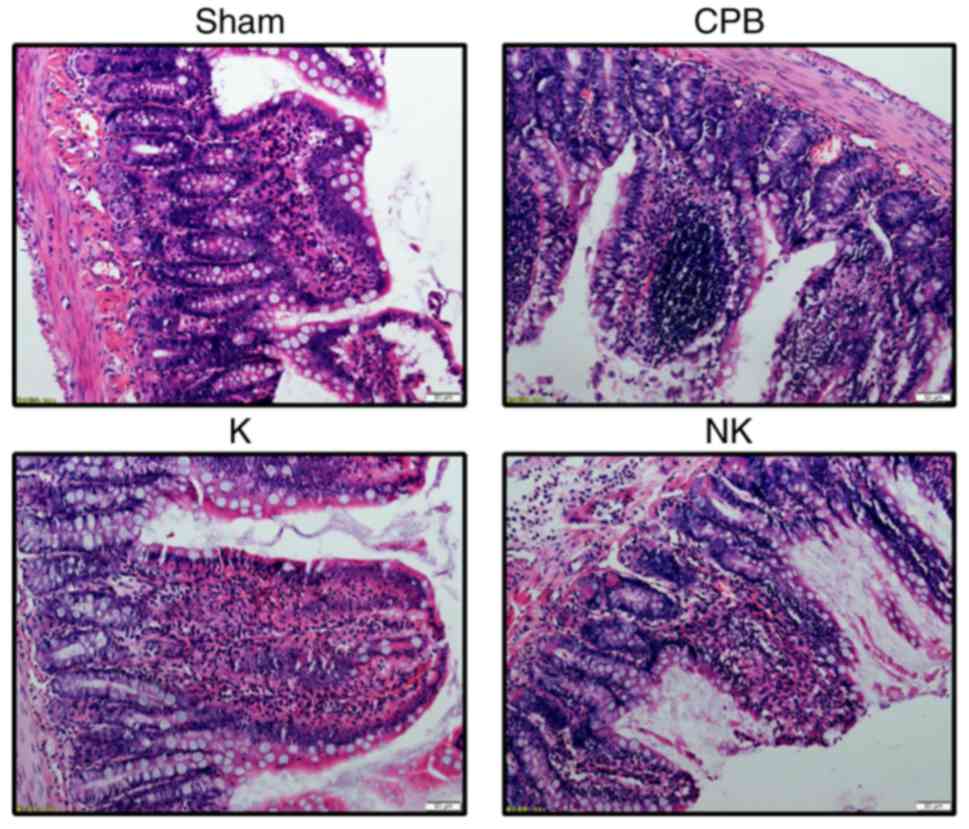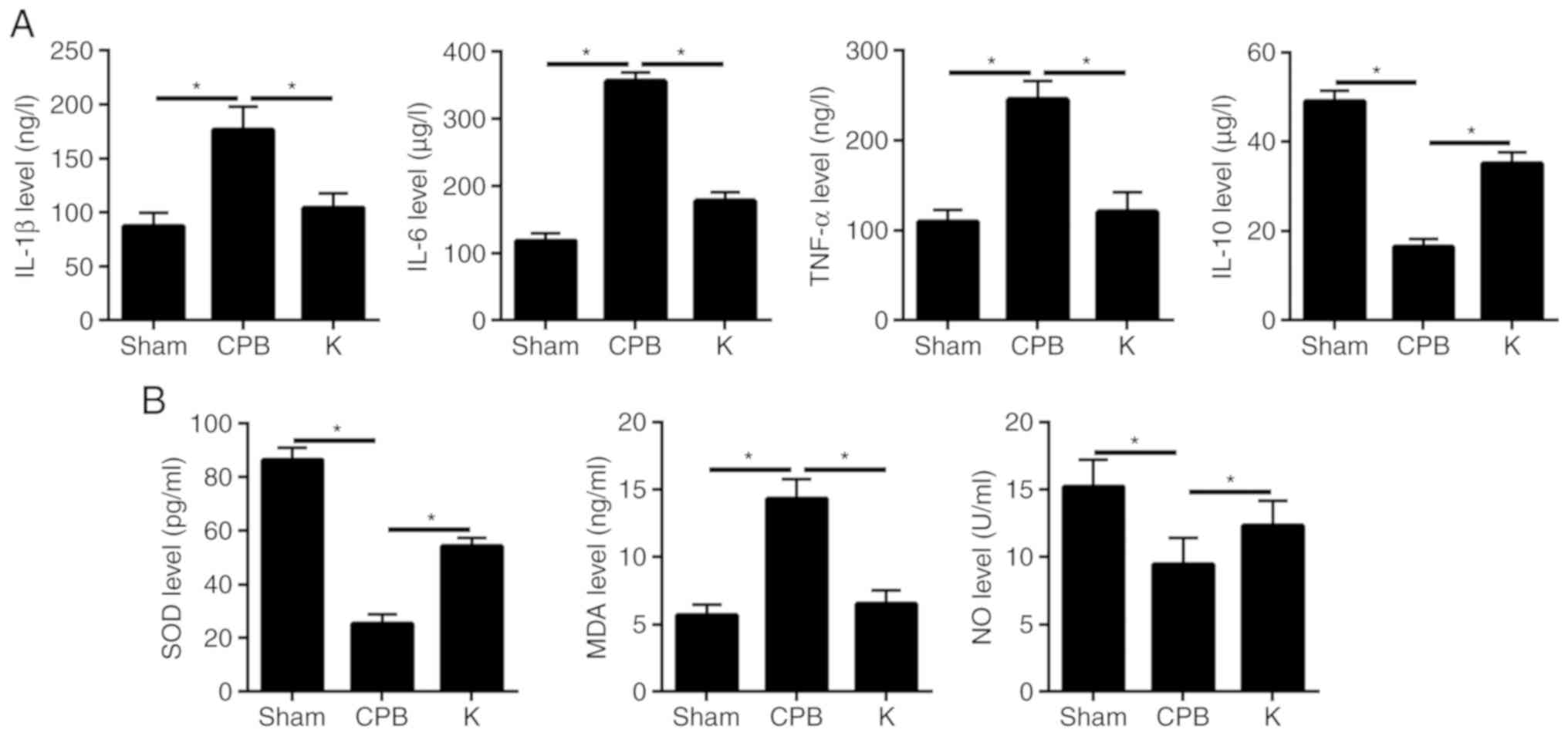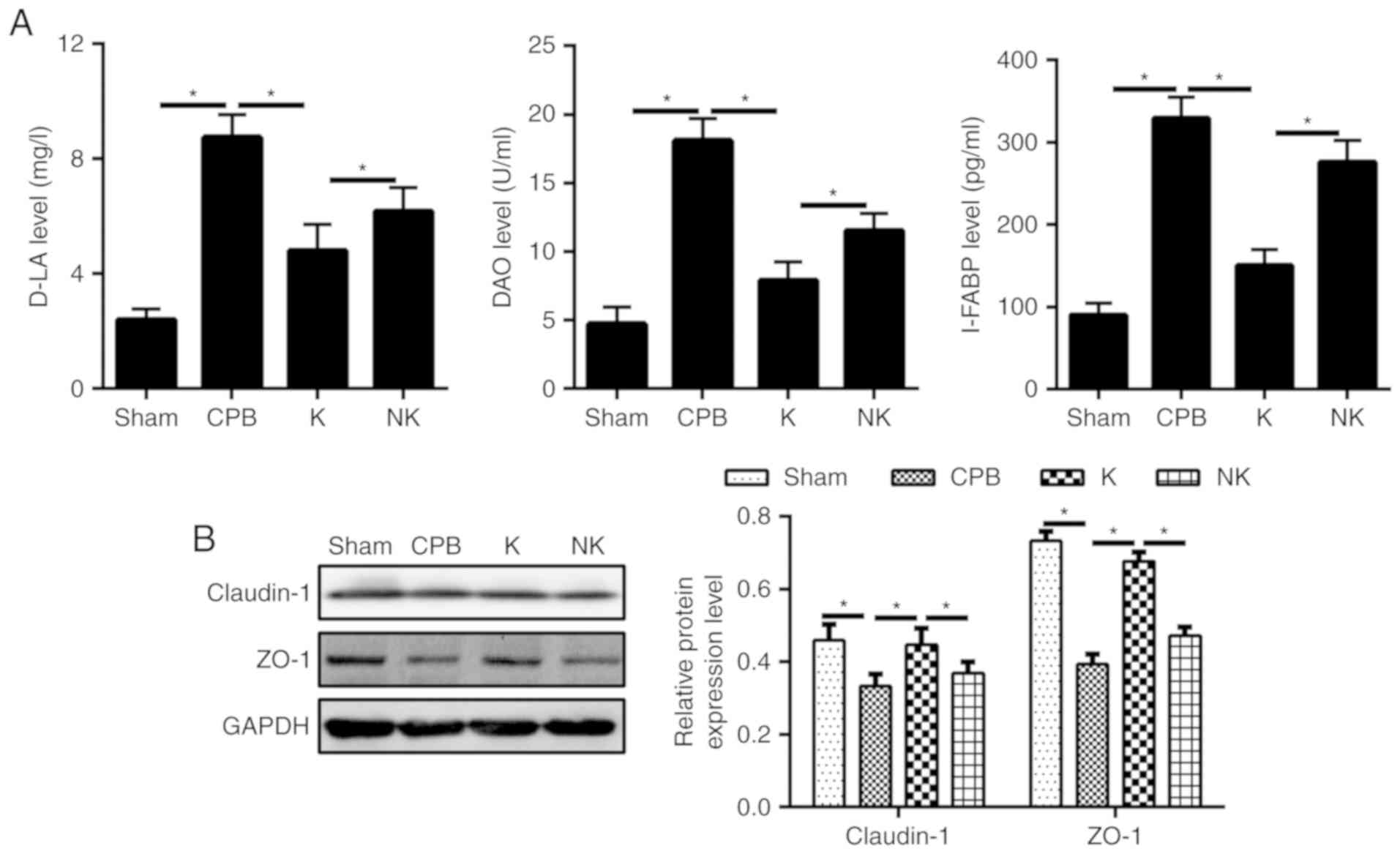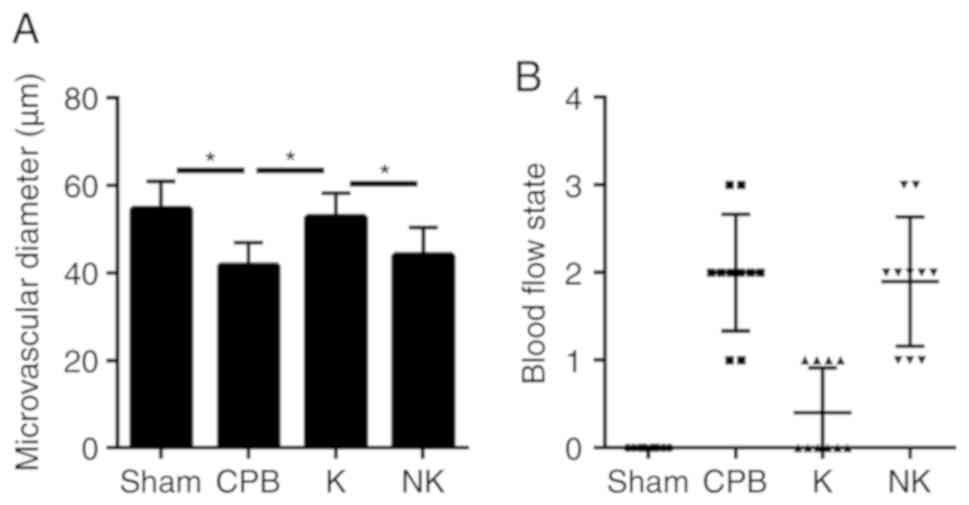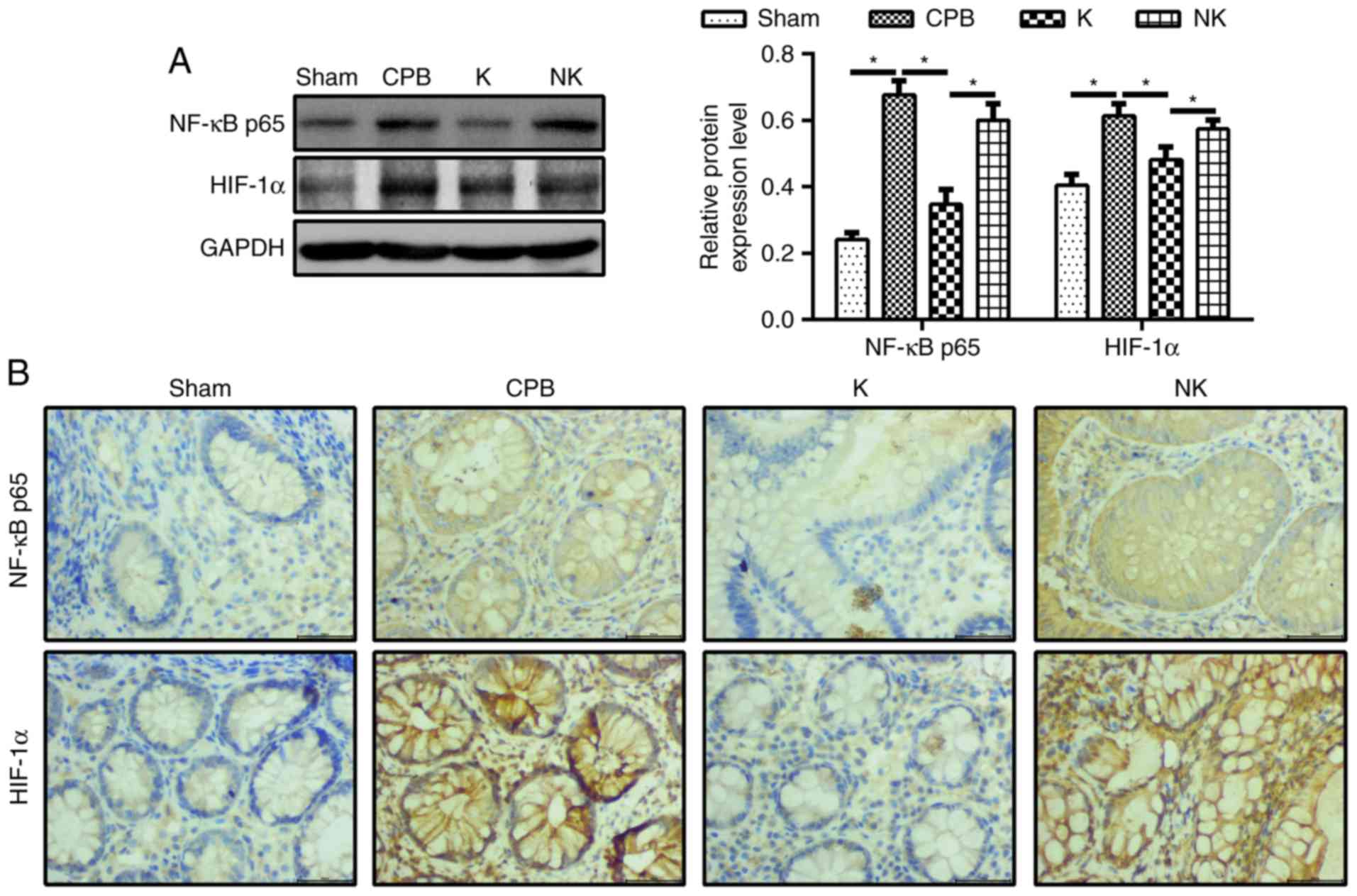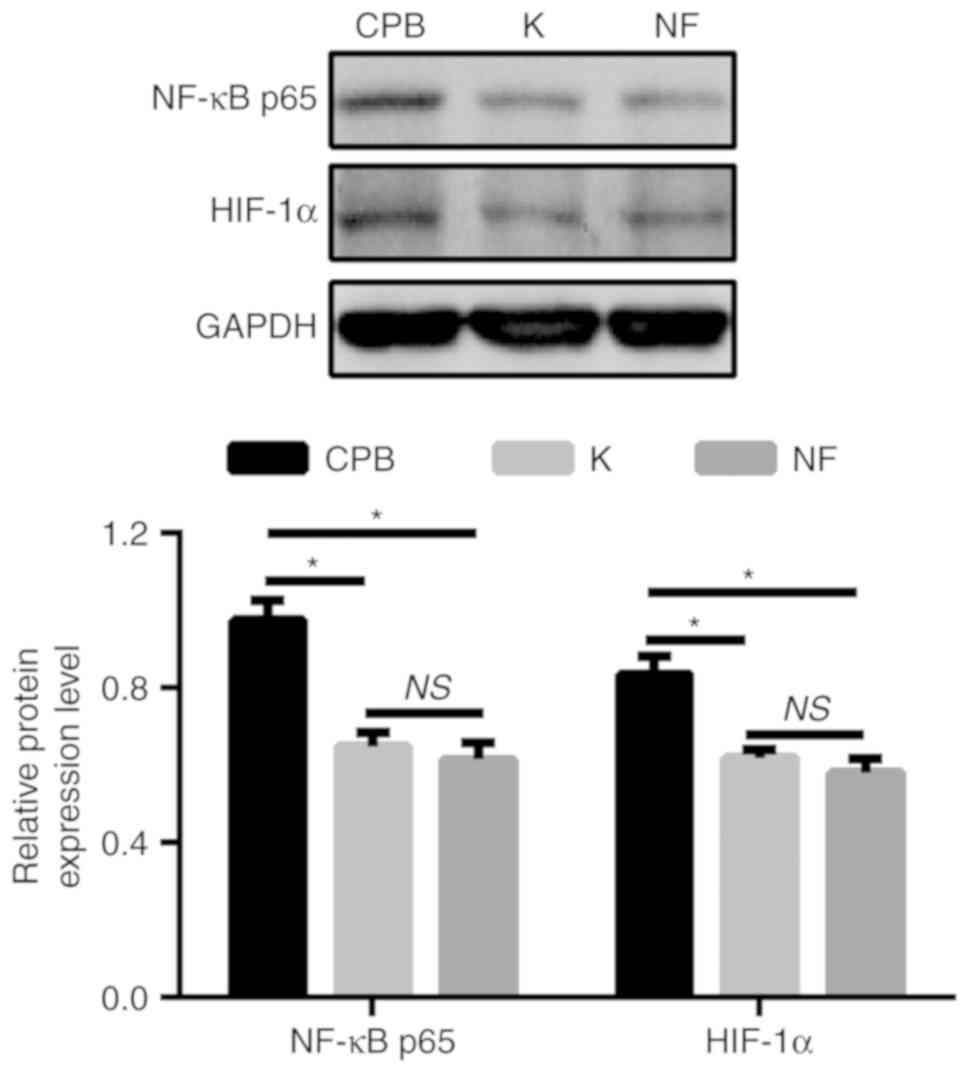κ‑opioid receptor agonists may alleviate intestinal damage in cardiopulmonary bypass rats by inhibiting the NF‑κB/HIF‑1α pathway
- Authors:
- Published online on: April 23, 2020 https://doi.org/10.3892/etm.2020.8685
- Pages: 325-334
-
Copyright: © Zhang et al. This is an open access article distributed under the terms of Creative Commons Attribution License.
Abstract
Introduction
As modern medical technology develops, the number of patients undergoing cardiac surgery under cardiopulmonary bypass (CPB) has increased (1). CPB enables cardiovascular surgery to be safer and more practical, but complications from surgery can lead to a systemic inflammatory response (2). Previous studies have demonstrated that the intestinal tract plays a key role in the continuous occurrence and development of systemic inflammatory response syndrome (SIRS), as well as multiple organ dysfunction syndrome (3,4). The occurrence of gastrointestinal complications following CPB cardiac surgery is <3%, but the mortality rate can be as high as 90% (5,6). Previous studies investigating the damage to and protection of tissues and organs caused by CPB have focused on the heart and brain (7,8). However, increased intestinal permeability and bacterial translocation occur in animal models and patients during CPB (9,10). Therefore, further study is needed into the intestinal complications of cardiac surgery. Prevention and treatment of intestinal damage during peri-intestinal circulation is crucial for reducing the incidence of complications and the mortality rate.
The κ-opioid receptor (KOR) serves a key role in regulating hypoxia and ischemia-induced damage (11,12), by mechanisms including protection of the microcirculation of skeletal muscle or activation of the PI3K/Akt signaling pathway (13). The KOR agonist U50448H protects against retinal ischemia-reperfusion injury in rats by activating the PI3K/Akt signaling pathway or via the production of tumor necrosis factor-α (TNF-α) in the retina (14). KOR agonists effectively reduce the occurrence of ischemia/reperfusion arrhythmia in rats (15,16). KOR agonists can also inhibit β-adrenergic receptors, thus reducing the contractile response of blood vessels as well as myocardial oxygen consumption (17). Zhang et al (18), has shown that KOR agonists can reduce pulmonary arterial hypertension caused by hypoxia by inhibiting pulmonary arterial smooth muscle cell proliferation and remodeling the pulmonary artery. However, the specific regulatory mechanism by which KOR agonists attenuate intestinal barrier damage following CPB remains unknown.
Hypoxia-inducible factor-1 (HIF-1) is a transcriptionally active nuclear protein that is produced by cells under hypoxic conditions and plays a key role in the hypoxic compensatory response of the body (19). HIF-1 is also important in cellular energy production, the metabolism of iron and catecholamines, as well as vasoconstriction, neovascularization and apoptosis in tumor cells under ischemic and hypoxic conditions (20-25). Previous studies have shown that HIF-1α is a disruptor of the intestinal mucosal barrier during hypoxia, ischemia-reperfusion and inflammation (26,27). HIF-1α can be activated not only by hypoxia, but also by several non-hypoxic stimuli, including various inflammatory mediators and cytokines (28,29). A common mechanism of these non-hypoxic stimuli of HIF-1α involves the upregulation of NF-κB-dependent HIF-1α expression levels (30).
In the present study, a model of post-operative intestinal barrier injury in rats undergoing CPB was established to observe the effects of a KOR agonist on intestinal barrier function injury, inflammation, oxidative stress response and the expression of NF-κB signaling pathway-associated proteins in CPB rats. In addition, the present study investigated the protective effect and mechanism of KOR agonists in the intestinal barrier of the CPB model rats. The present results may provide theoretical and experimental evidence that could facilitate the treatment of patients who have intestinal barrier function damage following CPB.
Materials and methods
Experimental animals and groupings
A total of 50 male Sprague Dawley rats, eight weeks old, specific pathogen free, 350-450 g were provided by the Animal Experimental Department of the General Hospital of Northern Theater Command [rodent use permit: SYXK (Military) 20120007; rodent production permit: SCXK (Military) 20120006]. All rats were in good health condition, maintained at 22-26˚C, in a 12 h light/dark cycle with 40-60% relative humidity in the animal rooms. Rats were maintained on standard laboratory diet with tap water ad libitum throughout the experiment, except for an overnight fast before surgery. The whole animal study has been reviewed and approved by Animal Ethical and Welfare Committee of The General Hospital of Northern Theater Command.
Rats were randomly divided into five groups, with 10 rats in each group. The groups were as follows: i) Sham operation (group Sham); ii) CPB surgery (group CPB); iii) KOR agonist (U50488H) + CPB (group K); iv) KOR agonist (U50488H) + specific KOR antagonist (norBNI) + CPB (group NK); and v) KOR agonist (U50488H) + NF-κB inhibitor pyrrolidinedithiocarbamic acid (PDTC) + CPB (NF group). The CPB rat model was established using a CPB bypass for all rats, with the exception of those in the sham group. In group K, an intravenous injection of 1.5 mg/kg U50488H (cat. no. 0495/25; Tocris Bioscience) was administered prior to the bypass. In group NK, an intravenous injection of 1.5 mg/kg U50488H was given after rats were catheterized and then 2 mg/kg norBNI (cat. no. sc-396970A; Santa Cruz Biotechnology, Inc.) was administered intravenously after 30 min (31,32). In group NF, 1.5 mg/kg U50488H was given intravenously after rats were catheterized, and then 50 mg/kg NF-κB inhibitor PDTC (cat. no. sc-203224A; Santa Cruz Biotechnology, Inc.) was injected intravenously 30 min later. After 2 h of CPB bypass, rats were anesthetized and following the intestinal microcirculation test (as described below), 5 ml of blood was taken from the right internal vein. The serum was separated by centrifugation 1,000 x g for 20 min and stored at -80˚C for subsequent experimentation. The jejunum and ileum tissues (section thickness, 2 µm) were stored at -80˚C for further analysis. Moreover, additional jejunum and ileum tissue (thickness, 2 cm) were immersed in 4% formalin for subsequent analysis.
Preparation of CPB model
CPB surgery was performed following the procedure described in a previous study (33). Rats received an intraperitoneal injection of 30 mg/kg pentobarbital sodium (Shanghai Ziyuan Pharmaceutical Co., Ltd.) every 2 h during surgery. Photopic oral intubation was conducted using a 16G intravenous catheter, and the rats were mechanically ventilated using a small animal ventilator (frequency, 60 beats/min; tidal volume, 3 ml/kg; inspiratory to expiratory ratio, 1:1.5), which was connected to a monitor to observe heart rate, oxygen saturation and rectal temperature.
The puncture site was sterilized using iodophor (Shandong Lierkang Disinfection Technology Co., Ltd.), which was followed by exposure and puncture of the femoral vein. Right femoral vein catheterization (24G) was performed in order to open the fluid path, which was then transfused with 6% hydroxyethyl starch (Guangdong Jiabao Pharmaceutical Co., Ltd.) and connected to a micro-infusion pump. In addition, the left femoral artery was catheterized (22G) and multi parameter ECG monitor (cat. no. CMS7000, Contec Medical Systems Co., Ltd.) used to monitor blood pressure. Both coccygeal artery catheterization (22G) and right internal jugular vein catheterization (18G) were performed so that blood could be drained for the CPB. A drainage tube, homemade blood storage device, constant peristaltic pump (Baoding Longer Precision Pump Co., Ltd.), silicone tubing (internal diameter, 4 mm) and rat membrane oxygenator (Guangdong Kewei Medical Instrument Co., Ltd.) were installed between the two puncture sites to establish the CPB circuit. Then, 300 IU/kg heparin sodium (Shenyang Haitong Pharmaceutical Co., Ltd.) was injected into the left femoral vein.
CPB was performed with a membrane oxygenator to supply oxygen; the low-flow CPB velocity was 35 ml/kg/min, which was later increased to 100-120 ml/kg/min at full-flow bypass. In order to prevent an air embolism, 1-2 ml of blood was retained in the blood storage device. Heart rate (HR) and mean arterial pressure (MAP) were monitored on a Gould ES2000 recorder (Gould, Inc.). Blood and body temperatures were maintained using heating lamps and controlled by esophageal temperature monitoring. Arterial blood gases taken from the right carotid artery were analyzed at 0, 30, 60, 90 and 180 min using a blood gas analyzer (GEM Premier 3000; Heal Force Bio-meditech Holdings Ltd. The mean arterial pressure was maintained at >60 mmHg, partial pressure of CO2 (PaCO2) 35-45 mmHg, base excess -3-3 mmol/l mmHg, pH 7.35-7.45 and hematocrit >0.25. 2-20 µg/100 g of epinephrine hydrochloride (Wuhan Grand Pharmaceutical Group Co., Ltd.) was infused into fluid during surgery to maintain rats stable circulation.
Intestinal microcirculation detection in rats
Once the rats were anesthetized, the abdominal cavity was incised. The lower part of the ileum was extracted and fixed securely in a constant temperature perfusion box, which was maintained at 37˚C with physiological saline. A microscope and medical image analysis system were connected to the box. The microvascular diameter of the same mesenteric vessel and the blood flow state of the rat were recorded using the microscope at 40-fold magnification. A semi-quantitative flow rate grading method was used to determine the blood flow state, which was divided into four levels (34): i) Level 0, characterized by fast vascular blood, a smooth vessel wall and a slight or no presence of debris in the blood vessels; ii) level 1, distinguished by a relatively faster blood flow and an obvious graininess in the blood vessels; iii) level 2, characterized by silt vessels and either a slow or variable blood flow; and iv) level 3, characterized by the stagnation or loss of blood flow. The rats were euthanized at the end of the study by an overdose of pentobarbital sodium (200 mg/kg).
Hematoxylin and eosin (H&E) staining
Jejunum and ileum samples in 4% formalin were dehydrated using an increasing ethanol gradient (70, 80, 90, 95 and 100%). The samples were then made transparent using xylene, waxed, embedded into paraffin blocks and then cut into 4-µm sections. After dewaxing, the sections were stained with hematoxylin for ~5 min and washed with PBS. Then, 1% hydrochloric acid was used for alcohol differentiation and 0.5% eosin dyeing solution was applied for 30 sec at room temperature. Gradient alcohol concentrations (70, 80, 90 and 100%) were used for dehydration, followed by transparentizing treatment and sealing using a neutral gum. Pathological changes to the tissues were observed using a light microscope (x200).
ELISA
ELISA kits were used to detect the inflammatory factors interleukin (IL)-1β (cat. no. CSB-E08055r; CUSABIO Technology), IL-6 (cat. no. SEA079Ra; Wuhan USCN Business Co., Ltd.), TNF-α (cat. no. SEA133Si; Wuhan USCN Business Co., Ltd.) and IL-10 (cat. no. SEA056Ra; Wuhan USCN Business Co., Ltd.) in the serum from the rats. In addition, the oxidative stress indicators superoxidase dismutase (SOD; cat. no. SES134Hu), malondialdehyde (MDA; cat. no. CEA597Ge), nitric oxide (NO; cat. no. IS100) and the intestinal injury markers D-lactic acid in serum (cat. no. CEV643Ge), diamine oxidase (DAO; cat. no. SEJ298Hu) and intestinal fatty acid-binding protein (I-FABP; cat. no. SEA559Ra) were detected in the serum using kits from Wuhan USCN Business Co., Ltd. The tests were performed according to the manufacturer's instructions.
Immunohistochemistry
Jejunum and ileum samples were fixed in 4% (v/v) formalin in distilled water at room temperature for 24 h. Samples were then separately dehydrated using an increasing concentration ethanol (70, 80, 90, 95 and 100%) for 30 min each at room temperature. The samples were then made transparent using xylene, waxed, embedded into paraffin blocks and cut into 4-µm sections. Subsequently, the sections were then incubated with 3% H2O2 for 10 min at room temperature and washed with PBS for 5 min. The sections were then incubated with primary antibodies against NF-κB-p65 (1:100; cat. no. ab207297; Abcam) and HIF-1α (1:500; cat. no. ab16066; Abcam), and washed twice with PBS for 5 min. Sections were incubated with HRP-labeled secondary antibody (1:500; cat. no. sc-2004; Santa Cruz Biotechnology, Inc.) for 1 h at room temperature and washed three times with PBS for 5 min. The slices were developed with 3,3'-diaminobenzidine at room temperature for 5 min and washed thrice with PBS for 5 min, before being counterstained with hematoxylin for 3 min. Sections were then washed thrice with PBS for 5 min, dehydrated, and sealed with neutral gum. The expression of NF-κB-p65 and HIF-1α were observed under light microscope (x400).
Western blotting
After homogenization of the jejunum and ileum tissues, pre-cooled RIPA (cat. no. 89900; Thermo Fisher Scientific, Inc.) buffer was added and lysis was conducted on ice for 30 min. Once the supernatant had been collected, the concentration of the collected protein solution was determined using a bicinchoninic acid protein quantification kit (cat. no. 23225; Thermo Fisher Scientific, Inc.). A total of 20 µg proteins were loaded and separated using a 10% SDS-PAGE electrophoresis and transferred to a PVDF membrane. After blocking with 5% low-fat milk buffer at room temperature, the PVDF membrane was incubated with zonula occludens-1 (ZO-1; 1:1,000; cat. no. ab96587; Abcam), claudin-1 (1:1,000; cat. no. ab15098; Abcam,), NF-κB-p65 (1:1,000; cat. no. ab207297; Abcam), HIF-1α (1:2,000; cat. no. ab16066; Abcam) and GAPDH (1:1,000; cat. no. ab37168; Abcam) antibodies overnight at 4˚C. After washing the PVDF membrane with PBS, a secondary antibody, goat anti-rabbit IgG H&L (horse radish peroxidase conjugated; 1:1,000; cat. no. ab205718; Abcam) was added and the membrane was incubated for 2 h at room temperature. Then, an ECL luminescence kit (GE Healthcare) was used to develop the color. A gel imaging system was used for imaging, and Quantity One (version 4.5.2. Bio-Rad Laboratories, Inc.) software was used for quantification of protein expression.
Statistical analysis
Statistical analyses were performed using SPSS 19.0 software (IBM Corp.). Multiple comparisons were analyzed using one-way ANOVA followed by Tukey's test. P<0.05 was considered to indicate a statistically significant difference.
Results
Rat hemodynamics
In the CPB model rats, the rectal temperature, pH, arterial blood PaCO2 and PaO2 were not significantly different from those in the sham group. However, the MAP, HR, left ventricular diastolic pressure, highest rate of change of pressure development and hemoglobin levels were significantly decreased in the CPB group compared with the sham group, and in group K these parameters were significantly increased compared with the CBP group (P<0.05; Fig. 1).
KOR agonist alleviates intestinal damage in CPB model rats
In the CPB model, the blood perfusion of important organs such as the brain is maintained, while that of the abdominal organs is suddenly reduced and eventually causes intestinal mucosal ischemia and hypoxia. The intestinal injury of the CPB model rats was assessed using H&E staining (Fig. 2). The results suggested that the intestinal mucosa, villi and brush border were normal in the sham group. However, the following were observed in the CPB group: Intestinal mucosal edema, infiltration of neutrophils and lymphocytes, partial atrophy and shedding of the villus, and filling of flaky capillaries. Following the addition of the KOR agonist, the intestinal mucosal injury in group K appeared to be attenuated compared with that in the CPB group; there was only mild partial villus edema, the intestinal epithelium and lamina propria were partially separated, and only minor inflammatory cell infiltration was observed. In group NK, the intestinal mucosa was thin, the intestinal villus was atrophied and inflammatory cell infiltration was observed. These results suggest that the intestinal mucosal damage in group NK was reduced compared with that in the CPB group, but not as much as that in group K. Collectively, the present results suggested that KOR agonists may alleviate intestinal damage in CPB rats.
KOR agonist inhibits the inflammatory and oxidative stress response in CPB model rats
The present study investigated changes in the levels of inflammatory and oxidative stress factors in the serum of rats using ELISA. In terms of the intestinal damage caused by CPB, factors associated with inflammation of the intestinal mucosa cells (Fig. 3A) and the oxidative stress response (Fig. 3B) were identified. The results suggest that the serum levels of IL-1β, IL-6 and TNF-α increased, while the level of IL-10 significantly decreased in group CPB compared with the sham group (P<0.05). In group K, the serum levels of IL-1β, IL-6 and TNF-α were decreased, while that of IL-10 was significantly increased compared with group CPB (P<0.05). The results for oxidative stress factors suggested that the levels of serum SOD and NO were decreased, and the level of MDA was significantly increased in the CPB group compared with the sham group (P<0.05). In addition, serum SOD and NO levels were significantly increased, and the level of MDA was significantly reduced in group K compared with group CPB (P<0.05). Therefore, the present results suggest that CPB triggers inflammatory and oxidative stress responses in intestinal mucosal cells, and that a KOR agonist reverses these responses.
KOR agonist improves intestinal mucosal function in CPB model rats
CPB-induced dysfunction of intestinal mucosa causes intestinal epithelial cells to release highly active DAO into the blood, increases the metabolism of D-lactic acid via gastrointestinal bacterial fermentation, and increases serum levels of I-FABP (35). The present results indicate that serum DAO, D-lactic acid and I-FABP levels were significantly increased in group CPB compared with the sham group (P<0.05). Compared with the CPB group, serum DAO, D-lactic acid and I-FABP levels were decreased in group K (P<0.05). In addition, DAO, D-lactic acid and I-FABP levels in group NK were significantly higher compared with those in group K (P<0.05). These results suggest that CPB-induced damage occurred in the intestinal mucosa of rats, and KOR agonists have the potential to ameliorate this damage (Fig. 4A).
Between epithelial and endothelial cells, tight junction molecules including the transmembrane proteins claudins, occludins, junctional adhesion molecules, ZOs and other peripheral proteins are involved in maintaining the internal environment and barrier function (36). In the present study, the protein expression levels of claudin-1 and ZO-1 were significantly decreased in the CPB group compared with the sham group, and were significantly increased in group K compared with group CPB (P<0.05). In addition, the protein expression levels of claudin-1 and ZO-1 in group NK were significantly decreased compared with those in group K (P<0.05; Fig. 4B). These results suggest that CPB may cause damage to the intestinal barrier in rats, and that KOR agonists could attenuate this damage.
KOR agonist improves intestinal microcirculation in CPB model rats
The present study estimated intestinal microcirculation by calculating the microvessel diameter (Fig. 5A) and blood flow state (Fig. 5B) in rats. In group CPB, the mean microvessel diameter value of rats was 41.74±5.18 µm, which was significantly narrower compared with that in the sham group (54.75±6.21 µm; P<0.05). The mean microvessel diameter value of rats in group K, which had been treated with KOR agonists was 52.83±5.42 µm, which was significantly increased compared with the CPB group (P<0.05). In group NK, in which rats were treated with a KOR agonist and KOR antagonist; the microvessel diameter was 44.11±6.34 µm, which was significantly narrower compared with that in group K (P<0.05).
When the blood flow state of the rats was assessed using a semi-quantitative flow rate grading method, the blood flow state of the 10 rats in the sham group was at level 0. However, in the CPB group there were two rats at level 1, six rats at level 2 and two rats at level 3. In addition, the blood flow state of the rats in group K showed some improvement compared with the CPB group. In group K, there were six rats at level 0 and four rats at level 1, while for group NK there were three rats at level 1, five rats at level 2 and one rat at level 3. Collectively, these results suggested that CPB may lead to microcirculatory disturbance in rats and that KOR agonists could significantly improve the intestinal microcirculation disturbance caused by CPB.
Effects of KOR agonist on the NF-κB/HIF-1α signaling pathway in CPB model rats
HIF-1α plays a role in destroying the intestinal barrier during hypoxia, ischemia-reperfusion and inflammation (37-39). Therefore, the present study further investigated the effects of a KOR on the intestinal barrier of CPB model rats by examining the expression levels of NF-κB-p65 and HIF-1α using western blotting (Fig. 6A). The results suggest that the protein expression levels of NF-κB-p65 and HIF-1α in intestinal tissue in the CPB group were significantly increased compared with those in the sham group (P<0.05). In addition, the expression levels of NF-κB-p65 and HIF-1α in group K were significantly lower compared with those in group CPB (P<0.05), and the expression levels of NF-κB-p65 and HIF-1α in group NK were significantly higher compared with those in group K (P<0.05). These results were also confirmed by immunohistochemistry (Fig. 6B). Therefore, the present results suggested that KOR agonists may attenuate intestinal damage in CPB model rats by inhibiting the NF-κB/HIF-1α signaling pathway.
KOR agonist improves intestinal mucosal function in CPB model rats via the NF-κB/HIF-1α signaling pathway
To further investigate the relationship between the KOR agonist, the NF-κB/HIF-1α signaling pathway and intestinal mucosal function in CPB rats, an NF-κB/HIF-1α signaling pathway inhibitor was administered to the rats. The results suggested that protein expression levels of NF-κB-p65 and HIF-1α in intestinal tissue were significantly decreased in group K compared with the CPB group (P<0.05). the expression levels of NF-κB-p65 and HIF-1α in group NF were also significantly decreased compared with those in the CPB group (P<0.05). However, no significant difference was found between groups K and NF (Fig. 7). The present results suggest that KOR agonists may improve intestinal mucosal function in CPB rats via the NF-κB/HIF-1α signaling pathway.
Discussion
Previous studies have found that pathophysiological mechanisms of CPB-induced intestinal barrier damage are associated with SIRS, while intestinal mucosal injury is caused by ischemia and hypoxia-reperfusion (40,41). Inflammatory responses caused by CPB include activation of various systems, including complement in blood serum, platelets and neutrophils, monocytes and macrophages, as well as the release of cytokines and leukotrienes in plasma (42). The results of the present study indicate that the TNF-α and IL-6 levels were significantly increased in rats after CPB, and were positively associated with increased intestinal permeability. Furthermore, they suggest that the inflammatory response caused by CPB may be closely associated with intestinal mucosal barrier dysfunction. In the present study, a rat model of CPD-induced intestinal injury was established in which the intestinal microcirculation was assessed and the intestinal tissues examined using H&E staining. Oxidative stress factors, inflammatory factors, intestinal injury markers and NF-κB/HIF-1α signaling pathway-related proteins were also investigated. The present study aimed to investigate the role of KOR agonists in the development and progression of intestinal barrier dysfunction in CPB model rats.
The expression of KOR mRNA has been detected in the heart, kidney, adrenal medulla, digestive tract, peripheral blood vessels, placenta, T cells and macrophages of many animal species, including humans and the uteri of pregnant mice (43-47). Therefore, KORs are widely distributed in the body and may be involved in the regulation of various physiological functions (43-47). Previous studies have confirmed that KOR agonists can be used to treat patients with diseases caused by hypoxia, ischemia or reperfusion (48,49). When the body is under stress, such as that caused by shock or ischemia, the endogenous opioid peptide system is activated and the cardiovascular center of the brain is regulated via the blood-brain barrier (50).
In addition to the negative inotropic, negative chronotropic and negative dromotropic effects caused by KORs on the heart, studies have shown that the activation of KORs can reduce the area of ischemia/reperfusion myocardial infarction and affect the occurrence of ischemia/reperfusion arrhythmias (15,16). The activation of KORs plays a role in cardioprotection (51,52). When CPB occurs, gastrointestinal tissue is also in an ischemic state, which leads to damage of the intestinal mucosa (9,10). The results of the present study reveal that a KOR agonist could inhibit the inflammatory response of CPB model rats, reduce oxidative stress, attenuate intestinal damage and relieve intestinal microcirculation, therefore reducing the occurrence and development of intestinal barrier dysfunction.
NF-κB is a key transcription factor that regulates the expression of numerous cytokines and inflammatory mediators, and plays a central role in the inflammatory response (53). Activation of the NF-κB signaling pathway promotes the transcription and release of inflammatory factors such as TNF-α and IL-6 during the inflammatory response (54). Therefore, inhibiting the activity of the NF-κB pathway can relieve the inflammatory response (55). Nicotine can attenuate the activation of the NF-κB signaling pathway caused by endotoxin (56,57). In addition, the α7 nicotinic acetylcholine receptor (α7nAchR) can inhibit the activity of transcription factor NF-κB, leading to attenuation of inflammatory cytokines (58). Furthermore, vagus nerve stimulation prior to α7nAchR antagonist treatment attenuated the destruction of the intestinal epithelial cells of rats with endotoxemia, which was mediated by the inhibition of NF-κB-p65 and transport of myosin light-chain kinase (59). The present results suggest that KOR agonists may significantly reduce the expression levels of NF-κB p65 and HIF-1α in intestinal tissues, thereby reducing intestinal damage in CPB model rats.
In conclusion, the present study revealed that a KOR agonist can reduce the inflammatory and oxidative stress response by decreasing intestinal barrier damage in a rat model of CPB, in which the intestinal barrier plays a key regulatory role. Collectively, the present results provide theoretical and experimental evidence on the prevention, occurrence, development and prognosis of intestinal impairment following cardiopulmonary bypass.
Acknowledgements
Not applicable.
Funding
This study was supported by The Liaoning Natural Science Foundation (grant no. 201602790) and The National Natural Science Foundation of China (grant no. 81471121).
Availability of data and materials
The datasets used and/or analyzed during the present study are available from the corresponding author on reasonable request.
Authors' contributions
YS and YD designed the research; XZ carried out the experiments. DS performed the data analysis. YS wrote the manuscript. All authors read and approved the final version of the manuscript.
Ethics approval and consent to participate
The study has been reviewed and approved by the Animal Ethical and Welfare Committee of The General Hospital of Northern Theater Command.
Patient consent for publication
Not applicable.
Competing interests
The authors declare that they have no competing interests.
References
|
Hirata Y: Cardiopulmonary bypass for pediatric cardiac surgery. Gen Thorac Cardiovasc Surg. 66:65–70. 2018.PubMed/NCBI View Article : Google Scholar | |
|
Evora PR, Bottura C, Arcêncio L, Albuquerque AA, Évora PM and Rodrigues AJ: Key Points for Curbing Cardiopulmonary Bypass Inflammation. Acta Cir Bras. 31 (Suppl 1):45–52. 2016.PubMed/NCBI View Article : Google Scholar | |
|
Chawla BK and Teitelbaum DH: Profound systemic inflammatory response syndrome following non-emergent intestinal surgery in children. J Pediatr Surg. 48:1936–1940. 2013.PubMed/NCBI View Article : Google Scholar | |
|
Osuka A, Kusuki H, Matsuura H, Shimizu K, Ogura H and Ueyama M: Acute intestinal damage following severe burn correlates with the development of multiple organ dysfunction syndrome: A prospective cohort study. Burns. 43:824–829. 2017.PubMed/NCBI View Article : Google Scholar | |
|
Geissler HJ, Fischer UM, Grunert S, Kuhn-Régnier F, Hoelscher A, Schwinger RH, Mehlhorn U and Hekmat K: Incidence and outcome of gastrointestinal complications after cardiopulmonary bypass. Interact Cardiovasc Thorac Surg. 5:239–242. 2006.PubMed/NCBI View Article : Google Scholar | |
|
Hashemzadeh K and Hashemzadeh S: Predictors and outcome of gastrointestinal complications after cardiac surgery. Minerva Chir. 67:327–335. 2012.PubMed/NCBI | |
|
De Hert S and Moerman A: Myocardial injury and protection related to cardiopulmonary bypass. Best Pract Res Clin Anaesthesiol. 29:137–149. 2015.PubMed/NCBI View Article : Google Scholar | |
|
Nan Z, Jin Z, Huijuan C, Tiezheng Z and Keyan C: Effects of TLR3 and TLR9 signaling pathway on brain protection in rats undergoing sevoflurane pretreatment during cardiopulmonary bypass. BioMed Res Int. 2017(4286738)2017.PubMed/NCBI View Article : Google Scholar | |
|
Sun YJ, Cao HJ, Jin Q, Diao YG and Zhang TZ: Effects of penehyclidine hydrochloride on rat intestinal barrier function during cardiopulmonary bypass. World J Gastroenterol. 17:2137–2142. 2011.PubMed/NCBI View Article : Google Scholar | |
|
Riddington DW, Venkatesh B, Boivin CM, Bonser RS, Elliott TS, Marshall T, Mountford PJ and Bion JF: Intestinal permeability, gastric intramucosal pH, and systemic endotoxemia in patients undergoing cardiopulmonary bypass. JAMA. 275:1007–1012. 1996.PubMed/NCBI | |
|
Tu IH, Yen HT, Cheng HW and Chiu JH: Baicalein protects chicken embryonic cardiomyocyte against hypoxia-reoxygenation injury via mu- and delta- but not kappa-opioid receptor signaling. Eur J Pharmacol. 588:251–258. 2008.PubMed/NCBI View Article : Google Scholar | |
|
Cheng L, Ma S, Wei LX, Guo HT, Huang LY, Bi H, Fan R, Li J, Liu YL, Wang YM, et al: Cardioprotective and antiarrhythmic effect of U50,488H in ischemia/reperfusion rat heart. Heart Vessels. 22:335–344. 2007.PubMed/NCBI View Article : Google Scholar | |
|
Lin JY, Hung LM, Lai LY and Wei FC: Kappa-opioid receptor agonist protects the microcirculation of skeletal muscle from ischemia reperfusion injury. Ann Plast Surg. 61:330–336. 2008.PubMed/NCBI View Article : Google Scholar | |
|
Husain S, Liou GI and Crosson CE: Opioid receptor activation: Suppression of ischemia/reperfusion-induced production of TNF-α in the retina. Invest Ophthalmol Vis Sci. 52:2577–2583. 2011.PubMed/NCBI View Article : Google Scholar | |
|
Lishmanov AY, Maslov LN, Lasukova TV, Crawford D and Wong TM: Activation of kappa-opioid receptor as a method for prevention of ischemic and reperfusion arrhythmias: Role of protein kinase C and K(ATP) channels. Bull Exp Biol Med. 143:187–190. 2007.PubMed/NCBI View Article : Google Scholar | |
|
Valtchanova-Matchouganska A, Missankov A and Ojewole JA: Evaluation of the antidysrhythmic effects of delta- and kappa-opioid receptor agonists and antagonists on calcium chloride-, adrenaline- and ischemia/reperfusion-induced arrhythmias in rats. Methods Find Exp Clin Pharmacol. 26:31–38. 2004.PubMed/NCBI View Article : Google Scholar | |
|
Sun X, Ma S, Zang YM, Lu SY, Guo HT, Bi H, Wang YM, Ma H, Ma XL and Pei JM: Vasorelaxing effect of U50,488H in pulmonary artery and underlying mechanism in rats. Life Sci. 78:2516–2522. 2006.PubMed/NCBI View Article : Google Scholar | |
|
Zhang L, Li J, Shi Q, Fan R, Kaye AJ, Wang Y, Sun X, Rivera FB, Kaye AD and Pei J: Role of κ-opioid receptor in hypoxic pulmonary artery hypertension and its underlying mechanism. Am J Ther. 20:329–336. 2013.PubMed/NCBI View Article : Google Scholar | |
|
Koyasu S, Kobayashi M, Goto Y, Hiraoka M and Harada H: Regulatory mechanisms of hypoxia-inducible factor 1 activity: Two decades of knowledge. Cancer Sci. 109:560–571. 2018.PubMed/NCBI View Article : Google Scholar | |
|
Anju TR and Paulose CS: Amelioration of hypoxia-induced striatal 5-HT(2A) receptor, 5-HT transporter and HIF1 alterations by glucose, oxygen and epinephrine in neonatal rats. Neurosci Lett. 502:129–132. 2011.PubMed/NCBI View Article : Google Scholar | |
|
Barben M, Schori C, Samardzija M and Grimm C: Targeting Hif1a rescues cone degeneration and prevents subretinal neovascularization in a model of chronic hypoxia. Mol Neurodegener. 13(12)2018.PubMed/NCBI View Article : Google Scholar | |
|
Chen Z, Wang C, Yu N, Si L, Zhu L, Zeng A, Liu Z and Wang X: INF2 regulates oxidative stress-induced apoptosis in epidermal HaCaT cells by modulating the HIF1 signaling pathway. Biomed Pharmacother. 111:151–161. 2019.PubMed/NCBI View Article : Google Scholar | |
|
Kappler M, Taubert H, Schubert J, Vordermark D and Eckert AW: The real face of HIF1α in the tumor process. Cell Cycle. 11:3932–3936. 2012.PubMed/NCBI View Article : Google Scholar | |
|
Requejo-Aguilar R, Lopez-Fabuel I, Fernandez E, Martins LM, Almeida A and Bolaños JP: PINK1 deficiency sustains cell proliferation by reprogramming glucose metabolism through HIF1. Nat Commun. 5(4514)2014.PubMed/NCBI View Article : Google Scholar | |
|
Urrutia AA and Aragonés J: HIF oxygen sensing pathways in lung biology. Biomedicines. 6(E68)2018.PubMed/NCBI View Article : Google Scholar | |
|
Cao M, Wang P, Sun C, He W and Wang F: Amelioration of IFN-γ and TNF-α-induced intestinal epithelial barrier dysfunction by berberine via suppression of MLCK-MLC phosphorylation signaling pathway. PLoS One. 8(e61944)2013.PubMed/NCBI View Article : Google Scholar | |
|
Wu C, Wang X, Jiang T, Li C, Zhang L, Gao X, Tian F, Li N and Li J: Partial enteral nutrition mitigated ischemia/reperfusion-induced damage of rat small intestinal barrier. Nutrients. 8(E502)2016.PubMed/NCBI View Article : Google Scholar | |
|
Kuschel A, Simon P and Tug S: Functional regulation of HIF-1α under normoxia--is there more than post-translational regulation? J Cell Physiol. 227:514–524. 2012.PubMed/NCBI View Article : Google Scholar | |
|
Nechemia-Arbely Y, Khamaisi M, Rosenberger C, Koesters R, Shina A, Geva C, Shriki A, Klaus S, Rosen S, Rose-John S, et al: In vivo evidence suggesting reciprocal renal hypoxia-inducible factor-1 upregulation and signal transducer and activator of transcription 3 activation in response to hypoxic and non-hypoxic stimuli. Clin Exp Pharmacol Physiol. 40:262–272. 2013.PubMed/NCBI View Article : Google Scholar | |
|
Mi Z, Rapisarda A, Taylor L, Brooks A, Creighton-Gutteridge M, Melillo G and Varesio L: Synergystic induction of HIF-1alpha transcriptional activity by hypoxia and lipopolysaccharide in macrophages. Cell Cycle. 7:232–241. 2008.PubMed/NCBI View Article : Google Scholar | |
|
Collins D, Powell G and Davies I: Cerebral activity prior to motion task performance: An electroencephalographic study. J Sports Sci. 9:313–324. 1991.PubMed/NCBI View Article : Google Scholar | |
|
Szeto HH, Soong Y, Wu D and Fasolo J: Resensitization of blood pressure response to mu-opioid peptide agonists after acute desensitization. Anesth Analg. 93:581–586. 2001.PubMed/NCBI View Article : Google Scholar | |
|
Zhou J, Zhou N, Wu XN, Cao HJ, Sun YJ, Zhang TZ, Chen KY and Yu DM: Role of the Toll-like receptor 3 signaling pathway in the neuroprotective effect of sevoflurane pre-conditioning during cardiopulmonary bypass in rats. Mol Med Rep. 12:7859–7868. 2015.PubMed/NCBI View Article : Google Scholar | |
|
De Backer D, Hollenberg S, Boerma C, Goedhart P, Büchele G, Ospina-Tascon G, Dobbe I and Ince C: How to evaluate the microcirculation: Report of a round Table conference. Crit Care. 11(R101)2007.PubMed/NCBI View Article : Google Scholar | |
|
Sun YJ, Chen WM, Zhang TZ, Cao HJ and Zhou J: Effects of cardiopulmonary bypass on tight junction protein expressions in intestinal mucosa of rats. World J Gastroenterol. 14:5868–5875. 2008.PubMed/NCBI View Article : Google Scholar | |
|
Sawada N, Murata M, Kikuchi K, Osanai M, Tobioka H, Kojima T and Chiba H: Tight junctions and human diseases. Med Electron Microsc. 36:147–156. 2003.PubMed/NCBI View Article : Google Scholar | |
|
Oliver KM, Taylor CT and Cummins EP: Hypoxia. Regulation of NFkappaB signalling during inflammation: The role of hydroxylases. Arthritis Res Ther. 11(215)2009.PubMed/NCBI View Article : Google Scholar | |
|
Hart ML, Henn M, Köhler D, Kloor D, Mittelbronn M, Gorzolla IC, Stahl GL and Eltzschig HK: Role of extracellular nucleotide phosphohydrolysis in intestinal ischemia-reperfusion injury. FASEB J. 22:2784–2797. 2008.PubMed/NCBI View Article : Google Scholar | |
|
Yang S, Yu M, Sun L, Xiao W, Yang X, Sun L, Zhang C, Ma Y, Yang H, Liu Y, et al: Interferon-γ-induced intestinal epithelial barrier dysfunction by NF-κB/HIF-1α pathway. J Interferon Cytokine Res. 34:195–203. 2014.PubMed/NCBI View Article : Google Scholar | |
|
Doguet F, Litzler PY, Tamion F, Richard V, Hellot MF, Thuillez C, Tabley A, Bouchart F and Bessou JP: Changes in mesenteric vascular reactivity and inflammatory response after cardiopulmonary bypass in a rat model. Ann Thorac Surg. 77:2130–2137; author reply 2137. 2004.PubMed/NCBI View Article : Google Scholar | |
|
Adamik B, Kübler A, Gozdzik A and Gozdzik W: Prolonged cardiopulmonary bypass is a risk factor for intestinal ischaemic damage and endotoxaemia. Heart Lung Circ. 26:717–723. 2017.PubMed/NCBI View Article : Google Scholar | |
|
Bronicki RA and Hall M: Cardiopulmonary bypass-induced inflammatory response: Pathophysiology and treatment. Pediatr Crit Care Med. 17 (Suppl 1):S272–S278. 2016.PubMed/NCBI View Article : Google Scholar | |
|
Hedner T and Cassuto J: Opioids and opioid receptors in peripheral tissues. Scand J Gastroenterol Suppl. 130 (sup130):27–46. 1987.PubMed/NCBI View Article : Google Scholar | |
|
Holzer P: Opioid receptors in the gastrointestinal tract. Regul Pept. 155:11–17. 2009.PubMed/NCBI View Article : Google Scholar | |
|
Liu LJ, Yu JJ and Xu XL: Kappa-opioid receptor agonist U50448H protects against renal ischemia-reperfusion injury in rats via activating the PI3K/Akt signaling pathway. Acta Pharmacol Sin. 39:97–106. 2018.PubMed/NCBI View Article : Google Scholar | |
|
Zhang S, Zhou Y, Zhao L, Tian X, Jia M, Gu X, Feng N, An R, Yang L, Zheng G, et al: κ-opioid receptor activation protects against myocardial ischemia-reperfusion injury via AMPK/Akt/eNOS signaling activation. Eur J Pharmacol. 833:100–108. 2018.PubMed/NCBI View Article : Google Scholar | |
|
Zhu Y and Pintar JE: Expression of opioid receptors and ligands in pregnant mouse uterus and placenta. Biol Reprod. 59:925–932. 1998.PubMed/NCBI View Article : Google Scholar | |
|
Tsibulnikov SY, Maslov LN, Mukhomedzyanov AV, Krylatov AV, Tsibulnikova MR and Lishmanov YB: Prospects of using of κ-opioid receptor agonists U-50,488 and ICI 199,441 for improving heart resistance to ischemia/reperfusion. Bull Exp Biol Med. 159:718–721. 2015.PubMed/NCBI View Article : Google Scholar | |
|
Xin J, Zhang Y, He Z and Wang Z: Highly selective non-opioid kappa opioid receptor (KOR) agonist salvinorin A protects against forebrain ischemia-induced brain injury in rats. Brain Res. 1637:168–176. 2016.PubMed/NCBI View Article : Google Scholar | |
|
Fraessdorf J, Hollmann MW, Hanschmann I, Heinen A, Weber NC, Preckel B and Huhn R: Role of Endogenous Opioid System in Ischemic-Induced Late Preconditioning. PLoS One. 10(e0134283)2015.PubMed/NCBI View Article : Google Scholar | |
|
Maslov LN, Lishmanov YB, Oeltgen PR, Barzakh EI, Krylatov AV, Naryzhnaya NV, Pei JM and Brown SA: Comparative analysis of the cardioprotective properties of opioid receptor agonists in a rat model of myocardial infarction. Acad Emerg Med. 17:1239–1246. 2010.PubMed/NCBI View Article : Google Scholar | |
|
Rong F, Peng Z, Ye MX, Zhang QY, Zhao Y, Zhang SM, Guo HT, Hui B, Wang YM, Liang C, et al: Myocardial apoptosis and infarction after ischemia/reperfusion are attenuated by kappa-opioid receptor agonist. Arch Med Res. 40:227–234. 2009.PubMed/NCBI View Article : Google Scholar | |
|
Hoesel B and Schmid JA: The complexity of NF-κB signaling in inflammation and cancer. Mol Cancer. 12(86)2013.PubMed/NCBI View Article : Google Scholar | |
|
Aziz RS, Siddiqua A, Shahzad M, Shabbir A and Naseem N: Oxyresveratrol ameliorates ethanol-induced gastric ulcer via downregulation of IL-6, TNF-α, NF-κB, and COX-2 levels, and up-regulation of TFF-2 levels. Biomed Pharmacother. 110:554–560. 2019.PubMed/NCBI View Article : Google Scholar | |
|
Piao H, Choi YH, Li H, Wang C, Xian Z, Ogasawara M, Jiang J, Li L, Yamauchi K and Yan G: Recombinant pyrin domain protein attenuates allergic inflammation by suppressing NF-κB pathway in asthmatic mice. Scand J Immunol. 89(e12720)2019.PubMed/NCBI View Article : Google Scholar | |
|
Café-Mendes CC, Garay-Malpartida HM, Malta MB, de Sá Lima L, Scavone C, Ferreira ZS, Markus RP and Marcourakis T: Chronic nicotine treatment decreases LPS signaling through NF-κB and TLR-4 modulation in the hippocampus. Neurosci Lett. 636:218–224. 2017.PubMed/NCBI View Article : Google Scholar | |
|
Liu Y, Yang J, Bao J, Li X, Ye A, Zhang G and Liu H: Activation of the cholinergic anti-inflammatory pathway by nicotine ameliorates lipopolysaccharide-induced preeclampsia-like symptoms in pregnant rats. Placenta. 49:23–32. 2017.PubMed/NCBI View Article : Google Scholar | |
|
Chen K, Sun Y, Diao Y, Ji L, Song D and Zhang T: α7 nicotinic acetylcholine receptor agonist inhibits the damage of rat hippocampal neurons by TLR4/Myd88/NF-κB signaling pathway during cardiopulmonary bypass. Mol Med Rep. 16:4770–4776. 2017.PubMed/NCBI View Article : Google Scholar | |
|
Zhao YX, He W, Jing XH, Liu JL, Rong PJ, Ben H, Liu K and Zhu B: Transcutaneous auricular vagus nerve stimulation protects endotoxemic rat from lipopolysaccharide-induced inflammation. Evid Based Complement Alternat Med. 2012(627023)2012.PubMed/NCBI View Article : Google Scholar |



